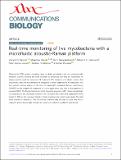Real-time monitoring of live mycobacteria with a microfluidic acoustic-Raman platform
View/
Date
14/05/2020Author
Grant ID
EP/P030017/1
115337
Keywords
Metadata
Show full item recordAbstract
Tuberculosis (TB) remains a leading cause of death worldwide. Lipid rich, phenotypically antibiotic tolerant, bacteria are more resistant to antibiotics and may be responsible for relapse and the need for long-term TB treatment. We present a microfluidic system that acoustically traps live mycobacteria, M. smegmatis, a model organism for M. tuberculosis. We then perform optical analysis in the form of wavelength modulated Raman spectroscopy (WMRS) on the trapped M. smegmatis for up to eight hours, and also in the presence of isoniazid (INH). The Raman fingerprints of M. smegmatis exposed to INH change substantially in comparison to the unstressed condition. Our work provides a real-time assessment of the impact of INH on the increase of lipids in these mycobacteria, which could render the cells more tolerant to antibiotics. This microfluidic platform may be used to study any microorganism and to dynamically monitor its response to different conditions and stimuli.
Citation
Baron , V O , Chen , M , Hammarstrom , B , Hammond , R J H , Glynne-Jones , P , Gillespie , S H & Dholakia , K 2020 , ' Real-time monitoring of live mycobacteria with a microfluidic acoustic-Raman platform ' , Communications Biology , vol. 3 , 236 . https://doi.org/10.1038/s42003-020-0915-3
Publication
Communications Biology
Status
Peer reviewed
ISSN
2399-3642Type
Journal article
Description
Funding: UK Engineering and Physical Sciences Research Council for funding through grant EP/P030017/1 and fellowship EP/L025035/1. This work was also supported by the PreDiCT-TB consortium [IMI Joint undertaking grant agreement number 115337, resources of which are composed of financial contribution from the European Union’s Seventh Framework Programme (FP7/2007–2013) and EFPIA companies’ in kind contribution (www.imi.europa.eu)] and the PanACEA consortium [funded by the European & Developing Countries Clinical Trials Partnership (EDCTP); grant agreement: TRIA-2015-1102]Collections
Items in the St Andrews Research Repository are protected by copyright, with all rights reserved, unless otherwise indicated.

